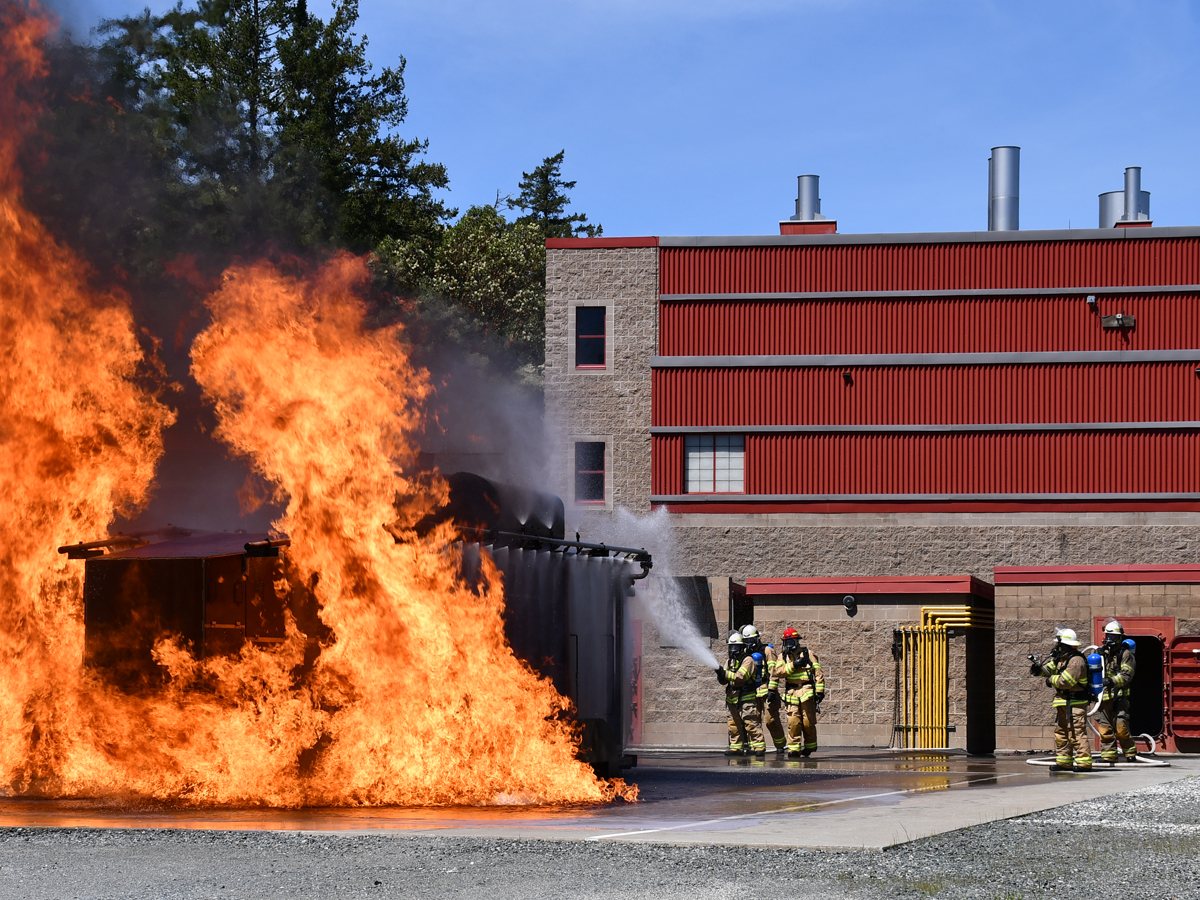New crash trainer enhances ship readiness
By Lookout Production on May 23, 2023 with Comments 0
Peter Mallett, Staff Writer — Spewing great balls of fire, a new helicopter crash rescue firefighting (HCRFF) trainer for Naval Fleet School – Pacific (NFS(P)) entered service at Damage Control Training Facility (DCTF) Galiano in Colwood on May 12.
The return of the HCRFF training capability is an important occasion for the Royal Canadian Navy (RCN) – for the last two years, Maritime Forces Pacific personnel had to conduct this specialty training at DCTF Kootenay, an identical facility in Halifax.
“We can finally get back to training our own helicopter crash rescue firefighters,” said Lieutenant-Commander (LCdr) Paul LePrieur, Damage Control Division Commander for Naval Fleet School (Pacific).
LCdr LePrieur said HCRFF training instruction is one of the foundations of operational excellence in Canada’s Navy. The training is mandatory for all members of the HCRFF team embarked in His Majesty’s Canadian (HMC) ships and required for ships to conduct flight operations.
Starting June 1 trainees will recommence practical exercises aimed at honing life-saving skills on how to respond to a helicopter emergency. The trainer is designed to resemble the Sikorsky CH-148 Cyclone embarked in HMC ships.
The HCRFF upgrade project in Halifax was completed in 2021. Efforts at DCTF Galiano were hampered by the effects of COVID-19, resulting in a two-year delay, said LCdr LePrieur. The new trainer incorporates many lessons learned from the earlier Sea King model, built by Kidde Fire Trainers (KFT) two decades ago. Enhancements include replaceable exterior panels and an increased water supply to protect the structure from heat stress and corrosion generated by the flames.
While the training serial is quite a spectacle to students and visitors, its arrival improves long-term sustainability at Fleet School and the RCN, says Commander (Cdr) Maude Ouellet-Savard, Commandant of NFS(P), who oversaw its implementation.
“It will enhance our ability to prepare sailors for service onboard ships,” Cdr Ouellet-Savard said, “which highlights why the training process is so fundamentally important to the RCN’s reconstitution efforts.”
It’s no small coincidence DCTF Galiano and DCTF Kootenay carry the names of two RCN vessels, said Rear-Admiral (RAdm) Christopher Robinson, Commander Maritime Force Pacific, who presided over the ribbon-cutting ceremony.
“Helicopter operations and Replenishment at Sea (RAS) refueling efforts are two of the most dangerous operations for sailors aboard ships during peace time,” he said.
HMCS Galiano was a patrol vessel during the First World War and saw 36 sailors lost at sea during a storm near Haida Gwaii in October 1918. HMCS Kootenay saw nine of its sailors killed and 53 injured from a gearbox explosion off the coast of England in October 1969.
“Both disasters speak to the importance of always being vigilant, always training and having world-class facilities such as this to preserve life,” RAdm Robinson said.
WHAT’S IN THE TRAINER:
A typical HCRFF serial sees trainees don protective firefighting gear and work with fire hoses in teams of three or four to knock down the flames and enter the aircraft to perform rescue operations. Pipes inside the crash trainer feed it natural gas for its flames and a sprinkler system provides water to prevent the structure from overheating, with intensity of the flames and flow of the water manipulated by technicians working in a nearby control tower.
General deterioration indicated sub-systems were nearing the end of their lives and there was an urgent need for their replacement. It resulted in a recapitalization project aimed at refurbishing the key components. In addition, the upgrade was an opportunity to change the configuration of the previous model based on the CH-124 Sea King design to the CH-148 Cyclone, currently in service in the Navy.
The new HCRFF trainers were built by US-based KFT Fire Trainers.
Partners of the HCRFF recapitalization project:
- Life Cycle Materiel Managers at DGMEPM,
- Defence Construction Canada,
- Real Property Operations (RPOps),
- Fleet Engineering,
- Naval Training Group HQ;
- Private sector partners.
DCTF Galiano
Damage Control Facility (DCTF) Galiano was named after the only Royal Canadian Navy (RCN) vessel lost during the First World War. DCTF Galiano entered service with the Royal Canadian Navy in May 2003.
The facility represents a safe and controlled environment for military staff to develop and deliver training to approximately 5,000 personnel per year for a wide range of specialty skills including:
- Firefighting (Initial, Refresher, Advanced, Submarine and Helicopter Crash Rescue specialties)
- Flood Control (Initial, Refresher)
- First Aid (Standard and Medical First Responder)
- Chemical, Biological, Radiological, and Nuclear Defence (CBRN)
- Damage Control (Battle Damage, Control System and Team Training)
- Hazardous Material (HAZMAT) Team Training
Source: Naval Personnel Training Group (NPTG)
Filed Under: Top Stories
About the Author:






